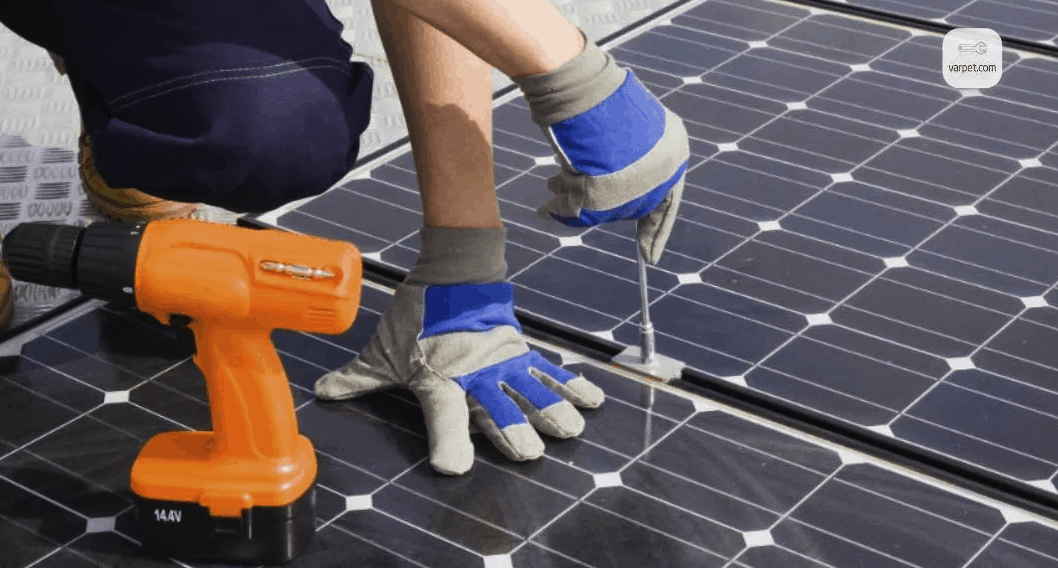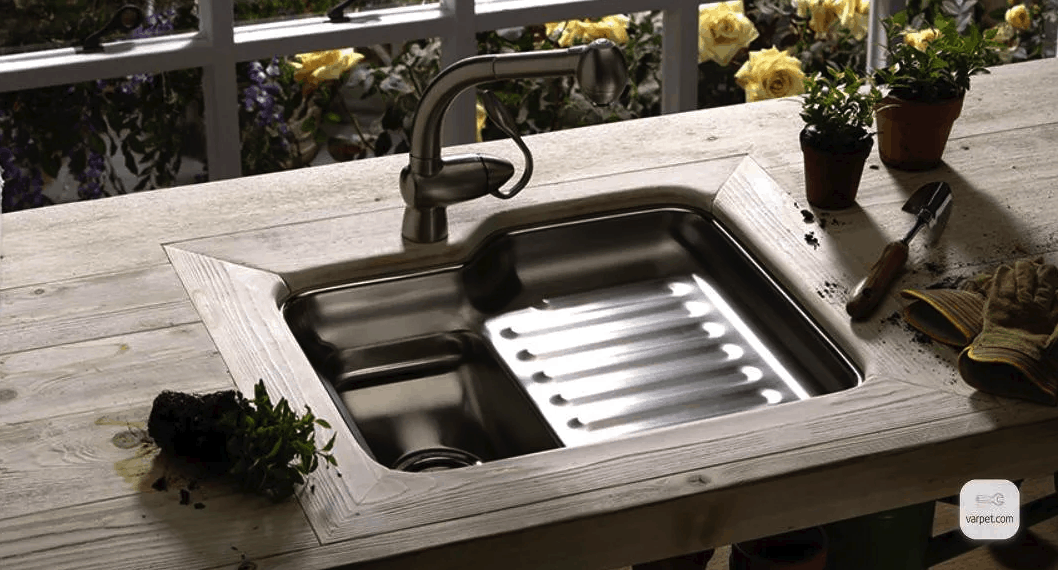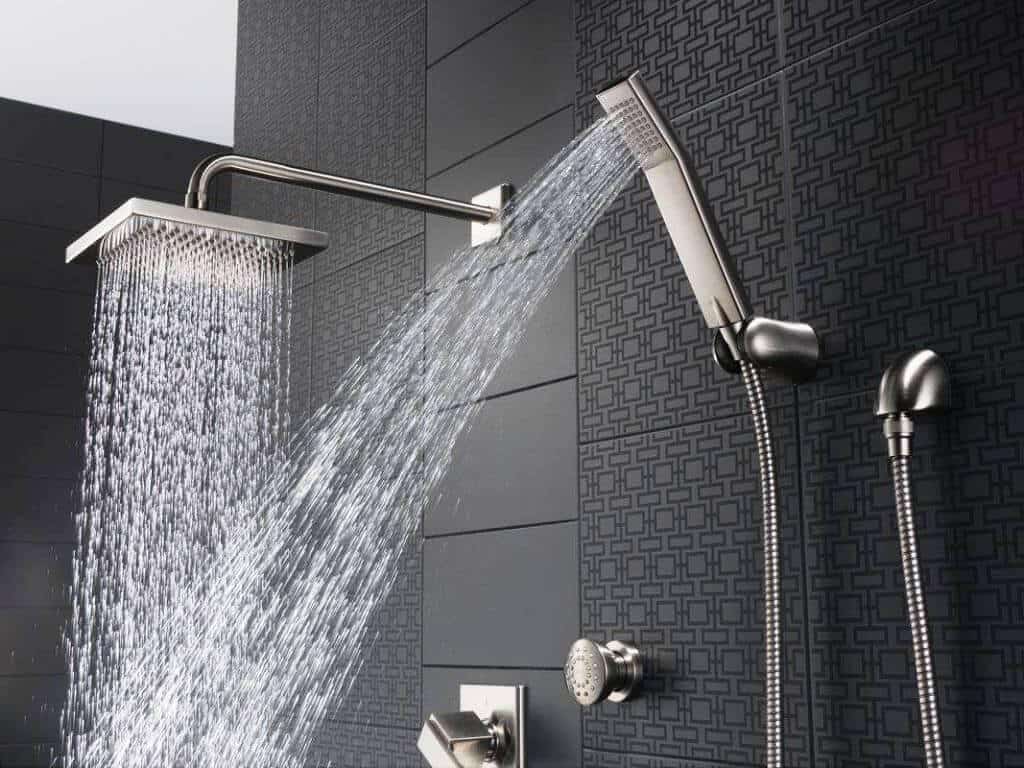The current years many homeowners have more alternate eastern electricity. The establishment of solar panels is gradually gaining popularity. It is not very far off in the sense of giving good fortune. Here are many things: how do you make your own batteries? The correct budget allocation breaks in the this article.
Solar battery – maintenance, transforming solar power into existing electric flow
What is a solar battery?
Solar battery – it’s a semiconductor device, converting solar power into electric power. The main task of such system is to provide trustful, economy and free electricity at home. Such facilities are purposefully to install in that places, where the existing facilities are provided by primary electricity.
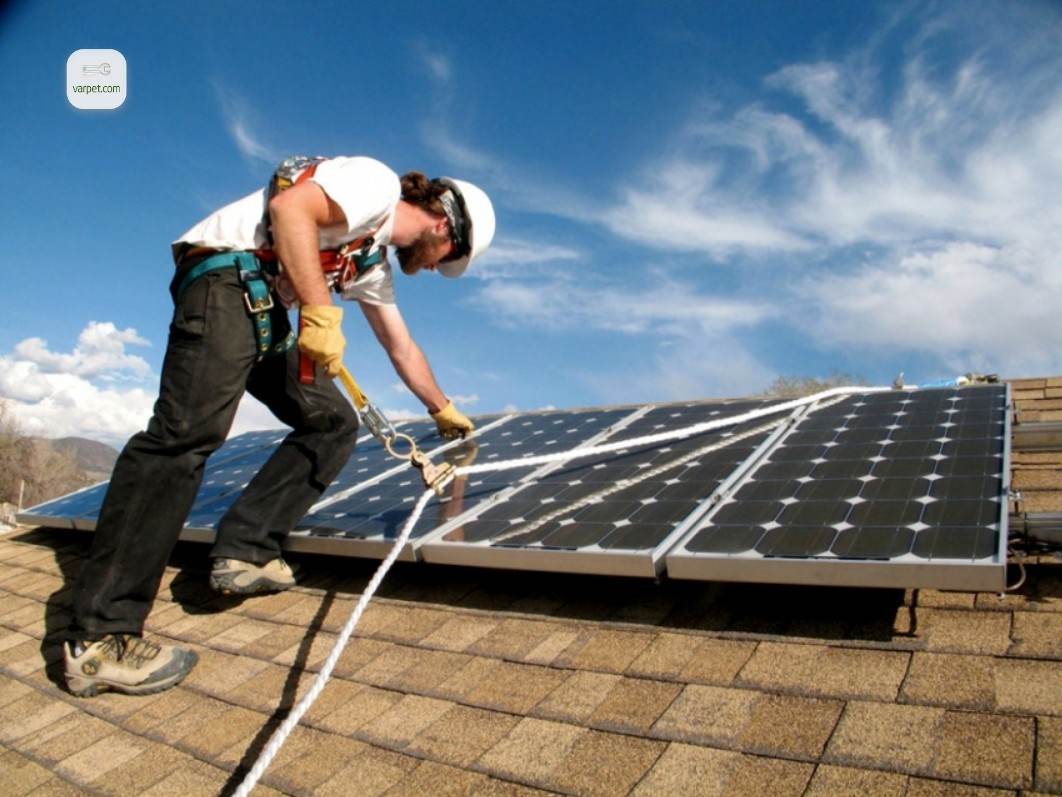
Solar electricity does not work efficiently at night, at such time as electricity usage is mostly at evening and night hours.
The main advantages of the solar battery are:
- simple installation of the device, which does not require laying cables to the supports;
- the system does not require large time costs for its maintenance;
- the generation of electricity does not adversely affect the environment;
- the design does not have moving parts;
- silent mode of operation;
- electricity supply is independent of the distribution network;
- long period of operation of the system at minimum cost.
The disadvantages of the solar battery:
- the manufacturing process of the system is very laborious;
- the solar panel takes up a lot of space;
- the device is very sensitive to contamination;
- the battery does not work at night;
- the efficiency of the device depends on weather conditions, namely on sunny and cloudy days.
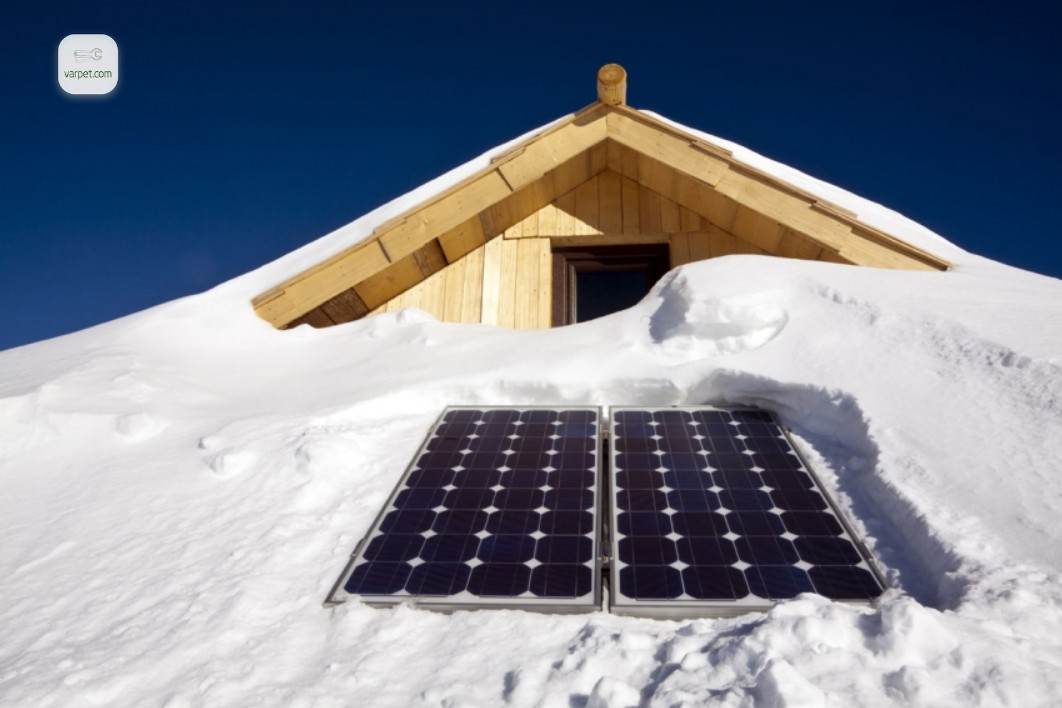
In winter, you should take care of the possibility of cleaning the solar panels from frost and snow
The principle of operation of the solar battery
The system operates through photovoltaic converters that are connected in a specific sequence. Each photoconverter consists of two silicon wafers, which differ in the type of conductivity. One is coated with phosphorus, resulting in the formation of an excess of negatively charged electrons. Another plate is covered with boron, which leads to the formation of particles, the so-called “holes”, which are absent in the layer of negative charges.
The principle of operation of an inexhaustible source of alternative energy is as follows: sunlight enters a negatively charged panel, which leads to the active formation of additional “holes” and electrons. On the panel coated with phosphorus, there is an electric field, due to which a potential difference appears. Positively charged particles rush to the upper layer, and negatively charged particles go to the lower layer. Constant voltage is created. It turns out that one converter works like a battery. A direct current occurs in the circuit when a load is connected to it. Each battery is covered with thin copper veins that divert current and guide it as intended.
The current strength depends on certain parameters:
- size of the photoconverter;
- level of insolation;
- type of photocell;
- total resistance of devices that are connected to the solar panel.
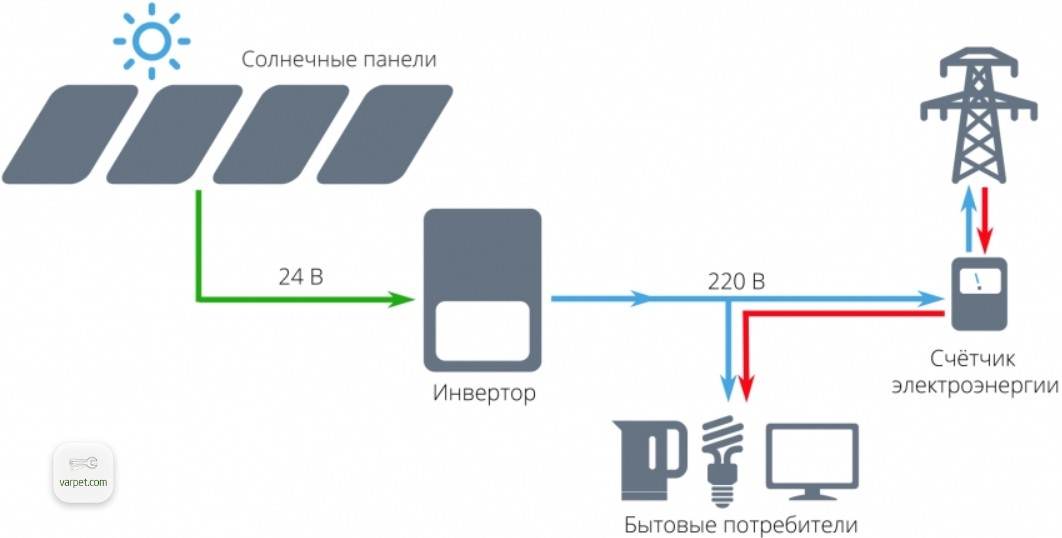
Scheme of connection and operation of the solar station
Varieties of Solar panels
All solar panels can be silicon or film. Panels based on silicon are divided into these types:
- polycrystalline;
- monocrystalline;
- amorphous.
The polycrystalline solar battery is a square device in dark blue. Its surface has inclusions of inhomogeneous silicon crystals. Despite the low efficiency of 18%, this device has the ability to generate current during cloudy weather, which makes them indispensable in areas where diffused sunlight prevails.
Monocrystalline converters of solar energy are represented by black panels with beveled corners, for which pure silicon is used. All cells of the device are directed in one direction, which allows to obtain a maximum efficiency of 25%. The disadvantage of such batteries is that their front side should always face the sun. If it did not have time to rise, hid behind the clouds and fell below the horizon, solar panels will produce a current of low power. This is the most expensive, but also providing maximum performance, type of device.
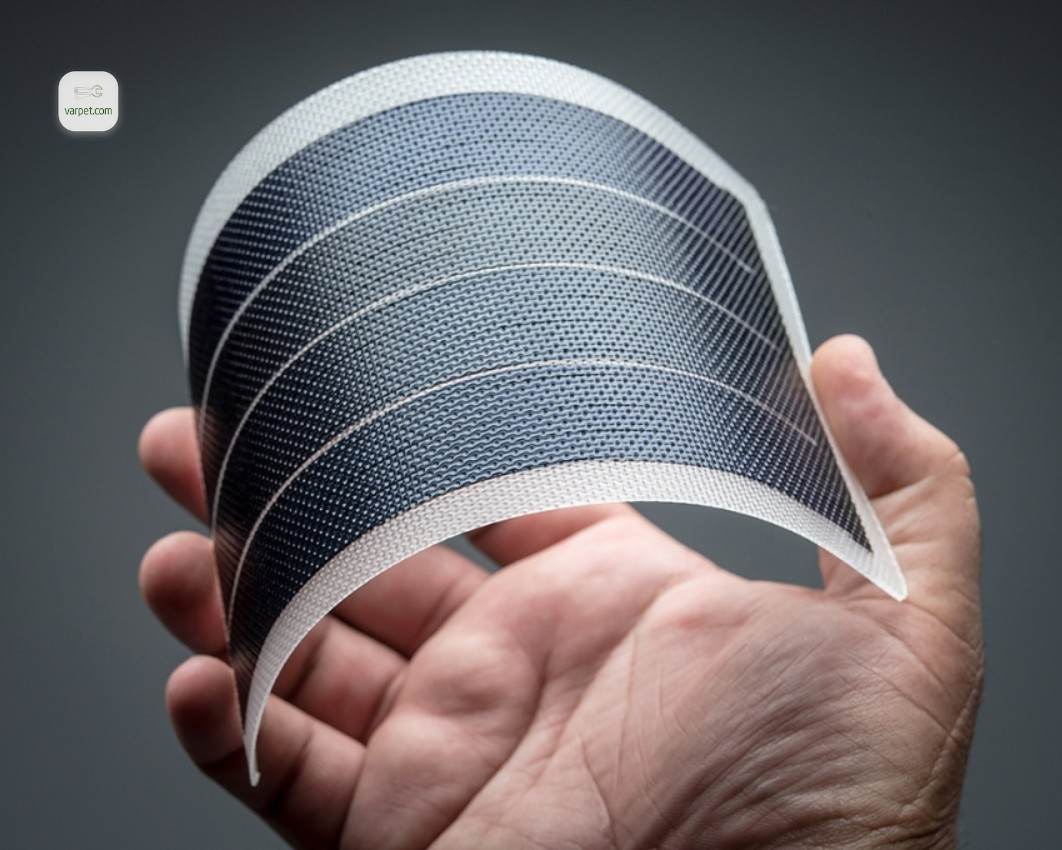
Flexible solar panel is easy to use – it can easily be attached to uneven areas of the roof
Each amorphous battery consists of many thin silicon layers, which are obtained by spraying the smallest particles of material onto glass, plastic or foil. Such layers quickly burn out, which already six months later leads to a decrease in the efficiency of the device by 15-20%. The efficiency of such converters is only 6%. They are the cheapest and able to work even in cloudy weather. However, their maximum service life is 2 years.
The basis of film batteries is not a solid substrate of metal or glass, but a polymer film. Therefore, they are produced in rolls, which allows you to spread the batteries over large areas. Due to its design, they can be cut into various shapes and sizes of parts, to place solar panels on the roof of the house with smooth bends. They are compact and lightweight. A roll panel will cost significantly less than a silicon one, for the manufacture of which expensive material is used. However, such models are less powerful. Buying them today is not easy, as production is only developing.
All solar panels, regardless of the type of device, are equipped with controllers that monitor the degree of charge of the panel. They redistribute the energy received, directing it to the source of consumption directly or storing it in the battery.
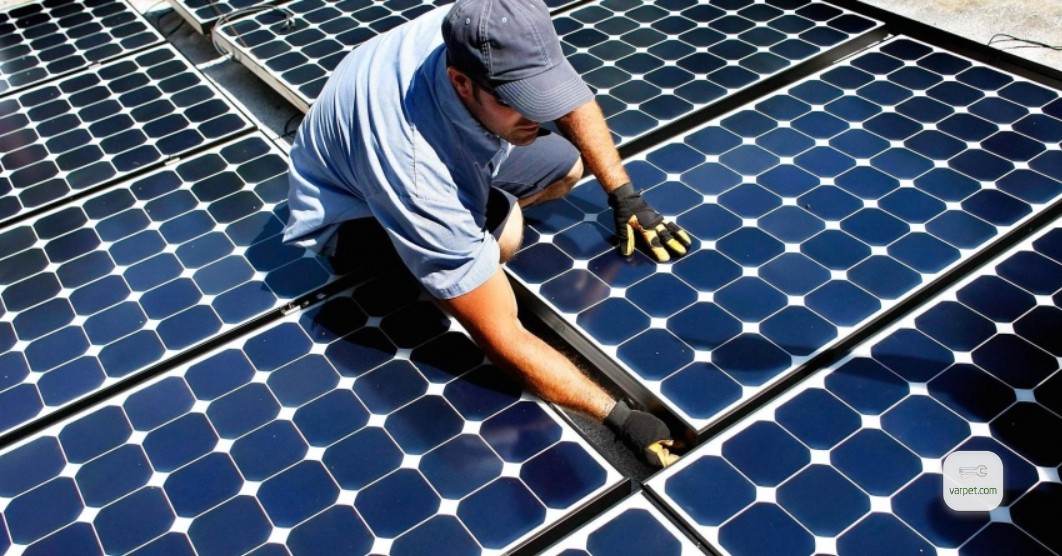
Install stationary solar panels is worth only on the sunny side of the house
Solar panels for a private house
Such an alternative to traditional power supply is very practical. In addition, the price of the device differs significantly from the cost of electricity. Having made a solar battery for the house with his own hands, the owner will be able to optimize power consumption and thereby reduce their own monetary costs. Many people want to understand in advance how much it will cost to install solar panels for a private house. For this, it is necessary to carry out preliminary calculations, where the necessary power of the equipment and the conditions of its operation are determined.
You should start by calculating the amount of energy consumed, which is necessary to provide housing. Creating a full-fledged station, it is worth focusing on batteries of 150-250 watts, for a country house it will be enough panels of 50 watts.
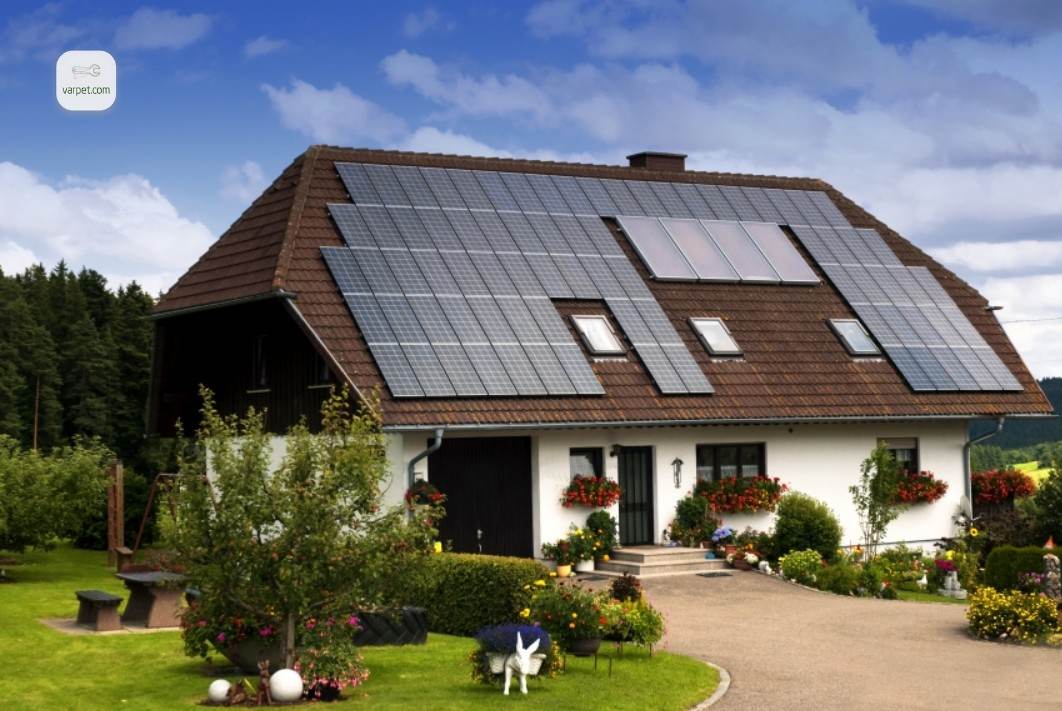
Solar panels are an alternative way to generate electricity, which will allow you to refuse the services of a utility
This value is the basis for the subsequent determination of the number of solar panels and the number of auxiliary equipment, which includes batteries, inverters and controllers.
Advice! An additional 20% should be added to the total electricity demand, which is spent in the batteries themselves.
An important aspect is insolation, that is, the amount of solar energy that falls on a separate unit area of the panels. This value is individual for each specific region. You can get it in the special literature or on specialized meteorological sites.
The energy norm is divided by the value of insolation. The resulting figure must be divided by the total power of the solar installation. The value obtained is the number of batteries needed. It is important to get the maximum number of panels. Indeed, in different months the amount of sunlight will be different.
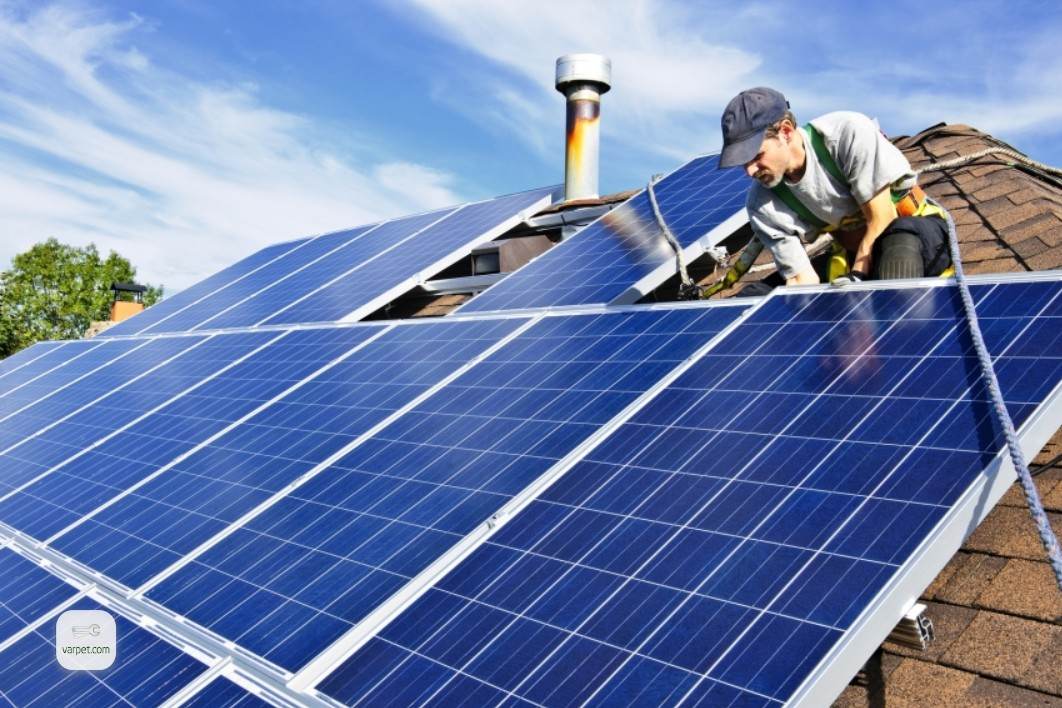
Before installing a solar station, you should make sure that it can cover the needs of all the appliances in the house
Advice! Since insolation is constantly changing, calculations should be carried out monthly.
For example, if you need to find out how many solar panels you need for a house of 100 sq.m., where the station will supply light bulbs, a laptop, a TV, a satellite dish, a microwave and an electric stove, all the above calculations should be performed. As a result, the power of the solar station will be approximately equal to 1000 watts, which involves the use of 4 solar panels with a capacity of 250 watts.
The panel must be located on the southern part of the roof, which must be in perfect condition and able to withstand a solid load. There should not be trees or other objects nearby that create a shadow.
Such a system can be used not only for power supply. Solar heating of a private house is becoming very popular. This allows you to get away from the expensive services associated with centralized gas supply, get rid of dependence on utilities, and receive year-round heat throughout the long life of the solar power station.
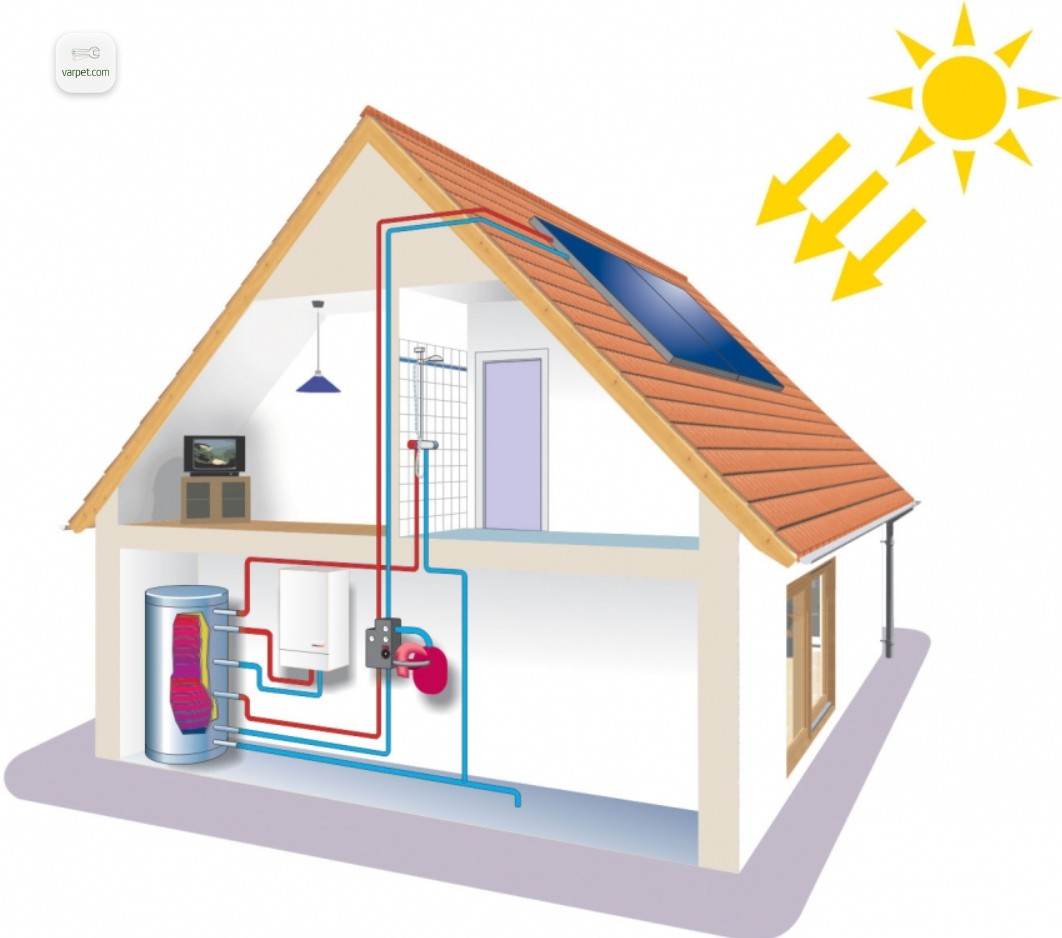
The principle of operation of a solar station connected to a heating element in a house
The installation of such a system is only suitable for those regions where the sun shines for at least 20 days a month. If the sun is not enough for the system to provide full heating at home, it can be used as an additional free source. A properly selected system of solar panels for heating a house will pay for itself in 3-4 years.
Solar panels for the home: consumer reviews
Thanks to the many positive reviews about the alternative source of electricity, it is possible to dispel the myths that worry potential people who want to install solar panels.
Many people think that such expensive equipment will not pay for itself throughout the entire service life of the installation. However, as practice shows, with the correct installation of solar panels in compliance with all the rules, it is possible to provide a private house with electricity for at least 25 years. And the cost of the equipment will pay off in 3-4 years.
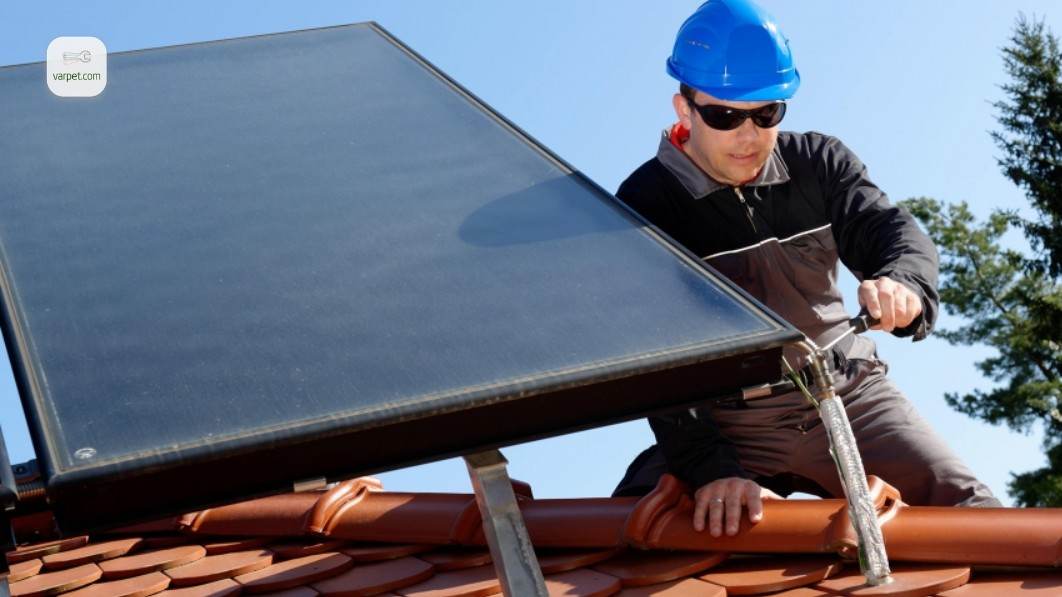
It is worth noting that the reviews of consumers of solar electricity are more positive
The following myth implies the inefficient operation of solar panels in cloudy weather or in winter. However, the opinions of consumers agree that the solar collectors are able to show maximum activity during the stay of the sun at its zenith in cloudless weather. But, when the sun hides behind the clouds, the panels will work, but not in full. The installation completely stops working at night when sunlight is completely absent.
Opponents of solar panels argue that solar collectors are quite fragile and are not able to withstand various loads created by nature. However, consumer reviews prove the opposite: a solar panel can withstand even a large hail.
The next myth concerns snow, which can block the access of light to the system. However, here the danger is frost, for which snow will cling and create obstacles. To avoid this, you can arrange the batteries on the house vertically, then you can avoid a lot of gliding light.
And the last myth concerns Chinese-made solar cells. Despite a very solid range of products, factories in China often produce high-quality goods. This is especially true for the manufacture of solar collectors and heat pipes, the production of which is 90% concentrated in China. These products have high technical characteristics and are certified not only in their own country, but also in Germany.
Numerous positive reviews on the Internet prove that an alternative source of electricity is good not only for a private home. Many successfully use solar panels for apartments, which are installed on the balcony. They can be fixed directly to the glass or in the glazing frame, which will play the role of tinting.
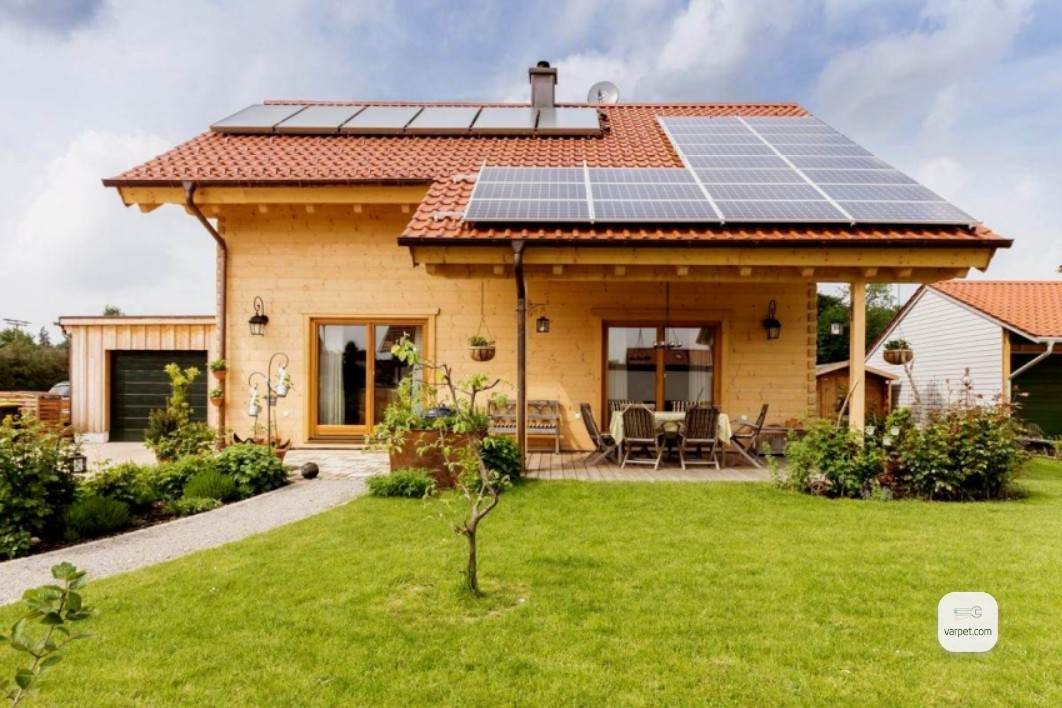
Some users claim that the solar station can fully cover all energy costs – from small household appliances to a heating and water heating system
Kits of solar batteries 3 kW per cottage from 447000 AMD
In the country, as a rule, there are electrical appliances of low power, where a limited number of batteries and a small frequency of their use are required. If there is no centralized power supply at the cottage, then it is advisable to install a set of solar panels, which will generate electricity for free. However, to get such a gratuitous pleasure, you will first have to spend money on the purchase of the necessary materials, the cost of which will pay off only after a few years.
To produce 1 kW of electricity, a kit with a capacity of more than 200 watts is needed. According to numerous reviews, solar power plants for a house in a country house with a capacity of 800 W are able to provide full autonomous power supply to the facility. The cost of such a system will cost from 600,000 AMD.
The standard set of a solar power station for a summer residence consists of 200 W panels, a 40 A charge controller, a 3 kW inverter, two 200 A batteries and other auxiliary parts. The price of such a set starts from 447000 AMD. And the approximate payback period is 3-5 years. However, this is the most profitable way to generate electricity for facilities without centralized power supply. It is less expensive than using a diesel generator.
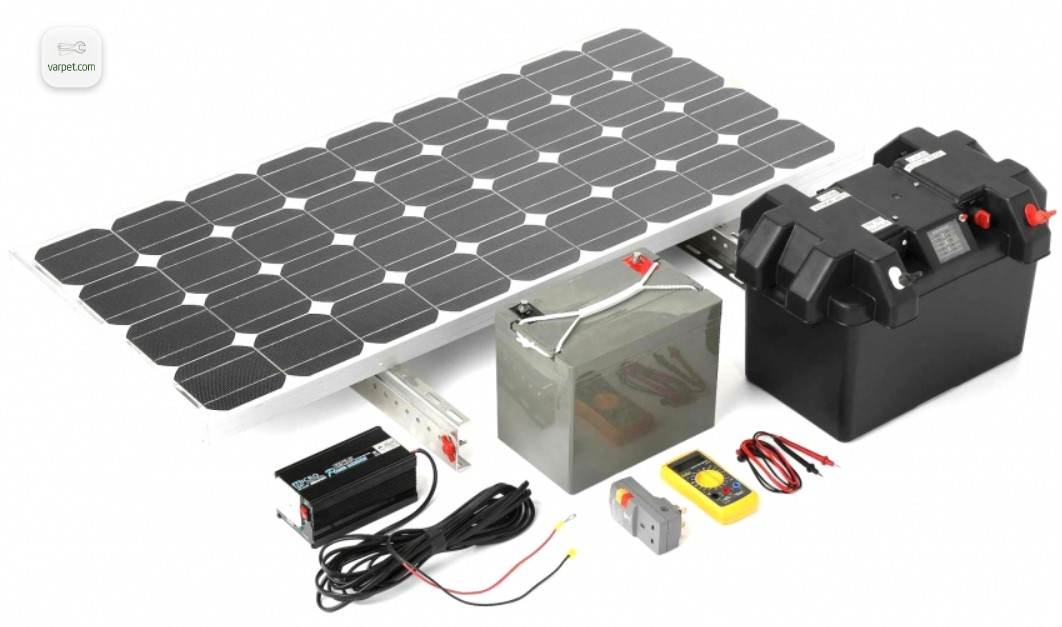
Solar station components
According to the reviews of the owners, it is better to equip solar panels for a house in a summer cottage with two or four modules with a capacity of 200 V each. It depends on the number of energy consumers, the duration and frequency of their use. If the power is not enough, it can be increased by adding solar panels.
Many people purchase such a kit for the private sector, where there is centralized power supply, as an additional source of energy. Numerous reviews about solar panels for the home indicate that in this case, you can significantly save on paying electricity bills.
How to make solar panels by own hands
When it is not possible to purchase a ready-made solar station, you can create it yourself. There are two options here: purchase ready-made modules and connect them to a battery with an inverter or solder the panel yourself. The first method of assembly is quick, but more expensive. The second option requires a certain skill of the collector, who must be extremely careful with fragile photocells.
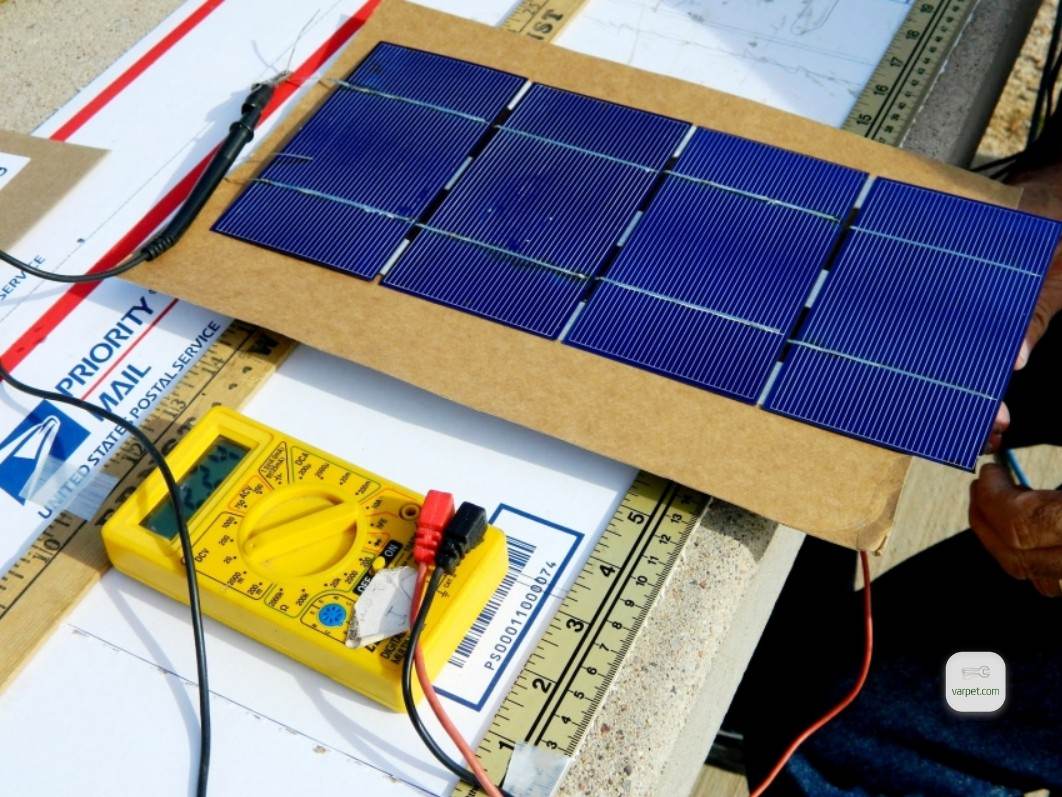
Four solar panels generate a total of 2V of electricity
To create a solar panel for your home, you need to prepare certain materials.
The first main component for creating solar panels is a set of high-quality solar cells. Today you can buy elements made of polycrystalline or single crystal silicon. More popular are the latest solar cells, which are ideal for home energy supply.
Advice! All items necessary for assembly should be purchased from one manufacturer. Since the materials of various brands differ significantly, which will complicate the assembly of the entire structure.
To connect the photocells, you need a set of special conductors. For the manufacture of the case of the future battery, aluminum corners resistant to weathering are suitable. Case size depends on the number of cells. It is better to use transparent polycarbonate or plexiglass as the outer coating of solar cells, which impede the penetration of infrared rays. As additional materials you will need fasteners, copper electrical wires, Schottky diodes, silicone vacuum coasters and a set of screws for fasteners.
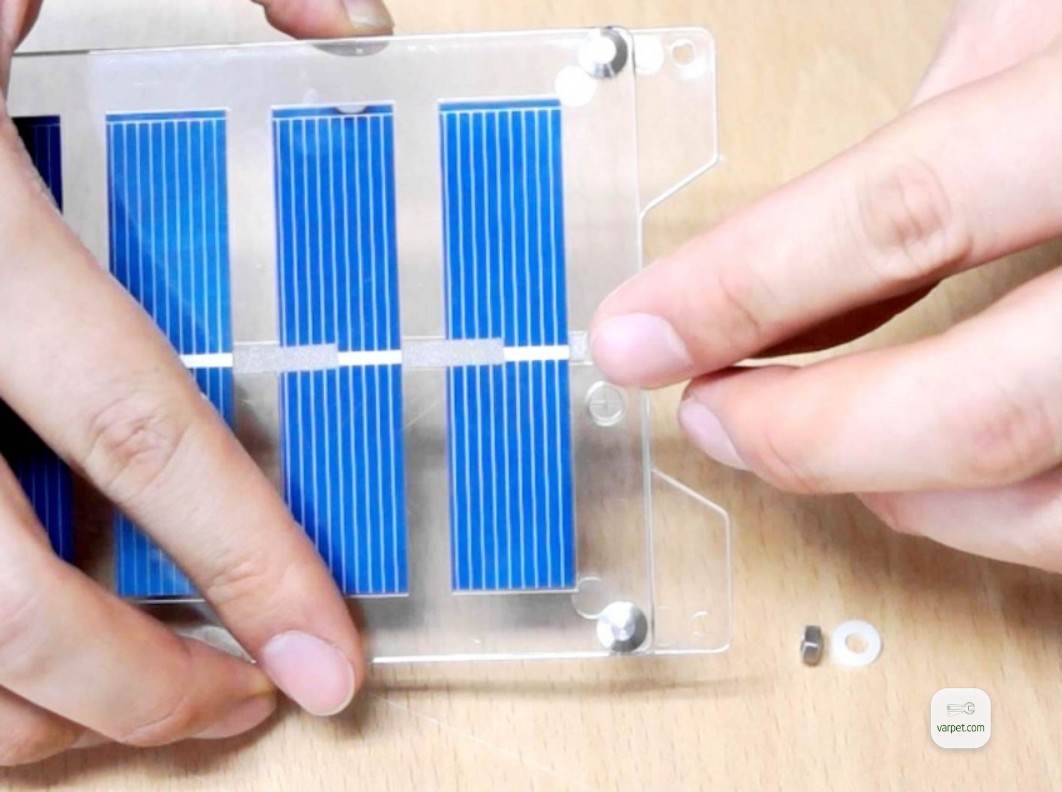
The solar battery can be assembled from improvised materials, but the efficiency of such a battery will not be high
In addition to the photovoltaic converter, you must buy a 12 V to 200 V inverter for the home, which converts direct current to alternating current. For the accumulation and slow consumption of electricity, a pair of gel or AGM batteries is required. An equally important element is the controller, which is necessary to disconnect the battery from the battery during its full charge and turn it on to receive a new portion of electricity.
You can also assemble a solar battery with your own hands from improvised means. For this, diodes, foil or transistors are suitable. The operation of the solar battery from the diodes occurs as a result of the appearance of voltage of about 2.5 V. in direct sunlight. However, when the sun is not enough, this indicator begins to rapidly fall, and the diodes themselves begin to consume energy. Using such a battery is ineffective.
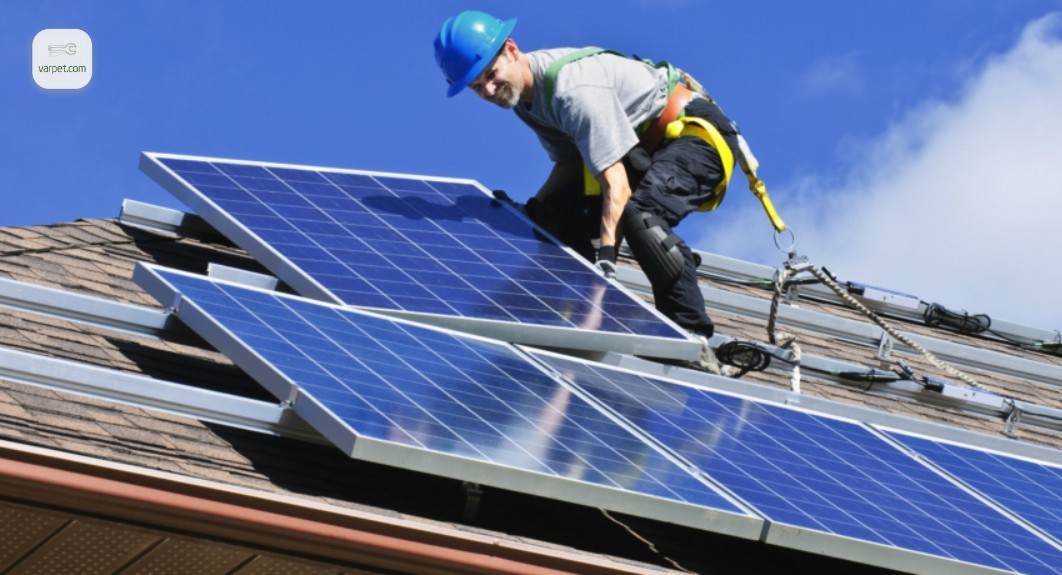
A solar station can be considered a long-term investment of money that will pay off and will be profitable in the future
Do-it-yourself solar panels for your home: step-by-step instructions for manufacturing
After all the necessary elements have been prepared, you can proceed to the assembly of the structure, which consists of the following steps:
- Creating a frame from aluminum corners with low sides and hardware, the size of which depends on the number of converters and their area. Here it is necessary to take into account the distance between the solar cells of at least 5 mm.
- Sealant should be applied to the inner edges of the rails.
- Lay a sheet of transparent material on the frame, pressing it tightly to the glue contour.
- After the sealant has completely dried, use the hardware to fasten the frame and the transparent surface.
- Lay out all the photocells of the battery with the minus side up on a flat surface.
- Using a soldering tool, conductors of the same length are connected to each photomultiplier. This is most conveniently done when the module is located on the glass.
- All elements are connected in series in the form of a “snake”.
- The extreme contacts must be soldered to the bus (silver wide conductor).
- To prevent a decrease in the quality of lighting in the dark, it is necessary to create “midpoints” using shunt diodes that are installed on the positive terminal. Schottky diodes are suitable for this.
- Lay photocells with conductors on a transparent plane.
- Lubricate all PECs that are output and connecting wires with silicone glue.
- Close the structure with the back panel.
- Connect the solar panel to the battery, solar charge controller and inverter.
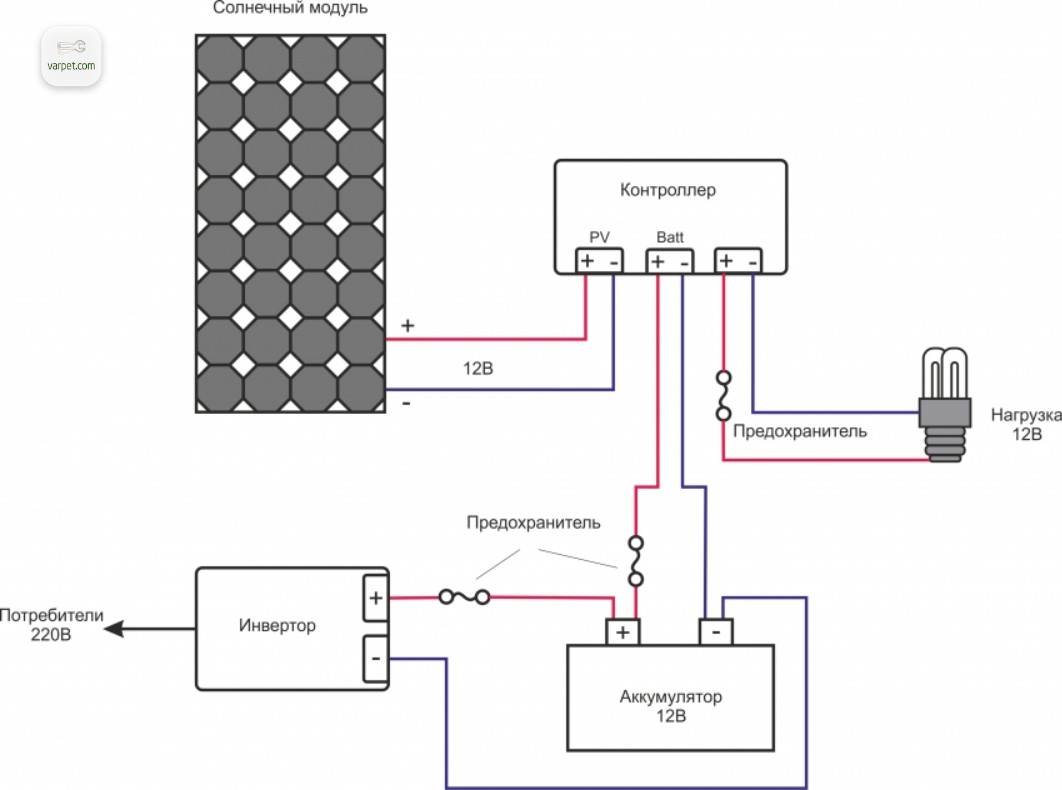
Simple solar panel connection diagram
Advice! To prevent a short circuit between the load and the individual battery cells, fuses must be installed.
Almost every homeowner wants to get free electricity. Installing solar panels is the most acceptable option. Using this device, you can create a main (without centralized power supply) and an additional source of electric energy. The system is environmentally friendly and reliable to use. The main disadvantage is expensive equipment. However, its cost will pay off in 3-5 years.

